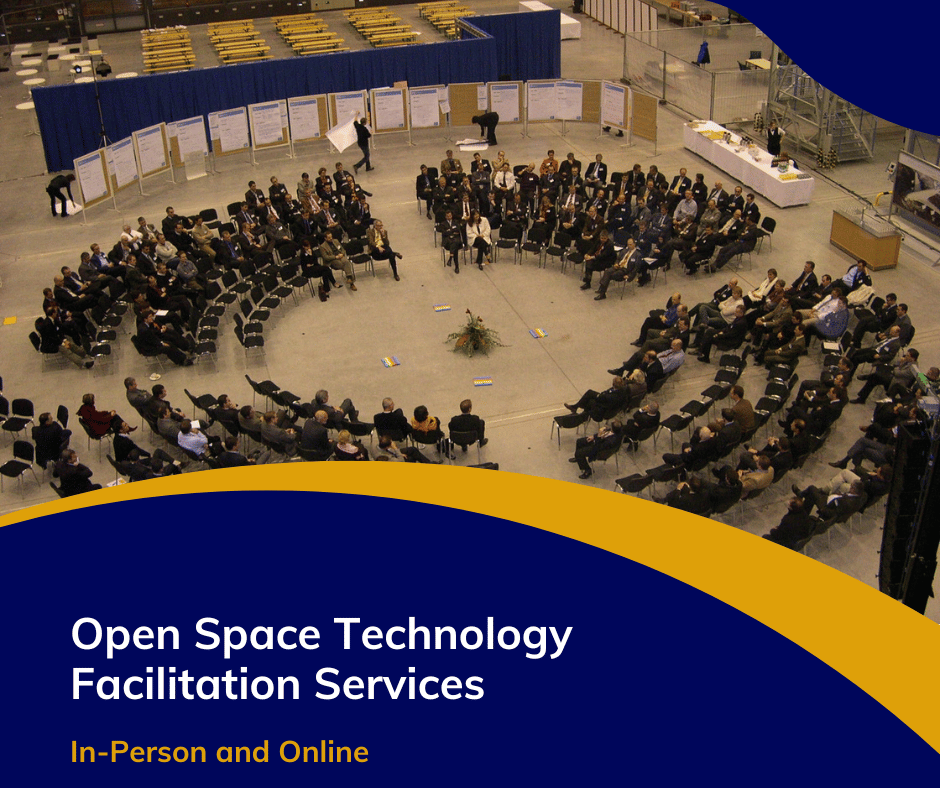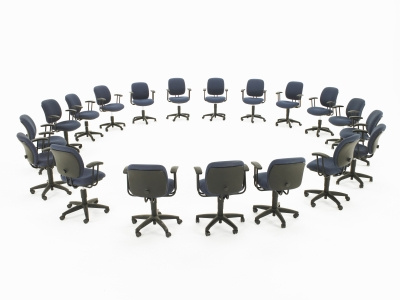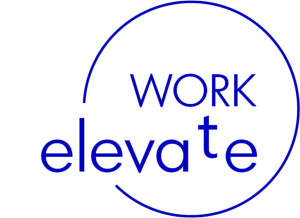How can Open Space Technology be used?
Open Space Technology can be used to achieve almost any business or community goal including:
- Creating a strategic plan
- Envisioning the future directions
- Resolving conflict in a groups or communities
- Building community and morale
- Self organized mentoring
- Conferences designed to engage participants
- Product planning and development
- Engaging conversation on a social issue such as peace, crime or climate change
- Organizing a social or business movement
- Reinventing, reviving or innovating your business
Open Space meetings effectively engage and empower participants to get results quickly.
Tangible Results of an Open Space Meeting
Each breakout group discussion is documented and gathered into a final "book of proceedings" which is the record of the highlights of the conversations.
A breakout meeting report typically includes the topic name, leader, participant names, highlights of the discussion and action steps. These reports are combined into a complete "book of proceedings" that is available for each participant. In a longer Open Space meeting, the "book of proceedings" is the basis for prioritizing and the development of further action steps which are included in the final report.
In-Tangible Results of an Open Space Meeting
Far more important and far-reaching, however, is the change which takes place in the minds of the participants, who emerge from the event as ambassadors for change within their organization or community. Participants experience:
- Breakthrough learning
- Genuine community and collaboration
- Spirited performance
- Playful involvement
- High efficiency and productivity
- Shared, empowered leadership
- Elimination of barriers to do a job with excellence and with pride
- Genuine excitement to be a part of the changes needed instead of fearing and resisting change
Open Space Technology is a dynamic, self-organizing process led by a facilitator
The venue for the Open Space Technology meeting is a large conference room with several "break-out rooms" or areas adjacent. When people arrive for the meeting, they initially come to large space which is empty except for a large circle of chairs. In the middle of the circle is a collection of newsprint paper, masking tape, and felt pens.
The Open Space meeting begins with a welcome by the sponsor that is brief, highlighting the theme and the "givens" and then a facilitator who explains how the Open Space Technology process will operate.
Creating the Open Space Agenda:
- Anyone who has any ideas, issues or opportunities that relate to this broad topic are invited to take a sheet of newsprint and write their name and topic of interest or passion. People are asked for ideas for which they have genuine passion and for which they are prepared to take the responsibility of leading a discussion group on that idea. They are also asked to make sure a record of the discussion is recorded (report forms are provided).
- The sheets announcing each of the ideas and a note of when and where the topic will be discussed are fixed onto a large blank wall. There are multiple breakout spaces available in multiple time slots. The group waits until all topics are announced and placed on the wall.
- The Agenda becomes a "market-place". Participants go to the market wall to look at the ideas outlined on each sheet and decide which topic discussions they wish to participate in; building their own personal agenda from the topics available.
Breakout Group Discussions:
- After the marketplace, participants break out to participate in the topics of their choice at the designated times. As far as possible, each breakout session is defined by a circle of chairs and no other furniture, though it may have flip charts, post-its, felt pens, etc.
- The person who posted the idea is responsible for leading the session in whatever way s/he chooses. The facilitator has no involvement whatsoever in the breakouts. The only requirement is that, at the end of the session, the session leader brings back to a central point a summary of session ideas, and who has agreed to do what. The highlights of the discussion are recorded in a standard format in a way that they can be understood by people who were not part of the discussion.
Creation of a 'Book of Proceedings
- A bank of computers is available and session leaders or a representative from the group enters the report into a computer. As soon as a report is entered, the facilitator prints a copy of it for a news wall and posts it so that all participants of the broader meeting can read about what has happened in each session.
- A copy of the report is made to be entered into a "book of proceedings", a book that is comprised of all of the reports and contact information of the participants so that they can reach each other for further networking. This book is available to each participant of the meeting.
- In a multi-day meeting, the "book of proceedings" is handed to each person prior to a time of converging the various topics and getting further input from the collective about next step actions. In a meeting that is one day or less, the "book of proceedings" is made available to participants within the week.
Convergence and Action Planning
In meetings where the intention is to move topics to action steps, the facilitator conducts a summarizing session for convergence, prioritizing and action planning, including seeking input on next steps and follow-up. This is a feature of Open Space Technology meetings that are longer than one day.
Morning and Evening News
Multi-day Open Space Technology meetings include 'Morning and Evening News'. This is at time at the beginning and end of each day where everyone gathers in the larger collective to share what they have created, discovered or learned with others. It is also a time to introduce additional topics for breakout discussion. At the end of the meeting there is a 'Closing Circle'
Open Space has been used around the world in almost every language, age and culture and with every kind of organization or community. It has been used effectively for a diverse range of purposes such as conferences, strategic planning sessions, mentoring, product development, community and team building, visioning, sales planning, customer engagement, organizing movements and conflict resolution. Open Space Technology has been used in groups ranging in size from 7 people to over a 1000!
Open Space facilitation can be done online with virtual teams.
Now, with effective, stable online video and online meeting technologies, Open Space has come into the online world. Imagine hundreds of people from around the world gathering in a live virtual space, focused on a purpose, creating an agenda together and breaking out into multiple simultaneous virtual video rooms to do their work. This is what is possible and the cost savings and possibilities for team collaboration are immense.
The Logistics of an Open Space Technology Meeting
Meeting the needs of your organization may require a one-day, two-day, or three day meeting. One-day meetings are good for raising the issues and opportunities and to make ownership of change possible. A two or three day meeting will go deeper into the issues and opportunities as well as identifying priorities, and developing these into steps for action.
It is required to have a large meeting room with a large blank wall on which tape can be used. It is also necessary to have several breakout rooms, depending on the size of the group. One breakout room per 20 people usually is a good formula.
Seating in the large meeting room is in one large or several concentric circles depending on the size of the group. Breakout rooms should also be set up with chairs in a circle with no tables. A separate room for meals is ideal, but sometimes it works to have meals buffet style in the main meeting room.
Supplies needed include flip chart paper, masking tape, markers, computers (one per 10 people), a printer, and paper. A public address system in the main meeting room is ideal with groups of 30 or more.
Open Space Technology has 4 Principles:
In Open Space meetings, 4 principles are explained to the group. These principles are also posted on the walls for everyone to see. They serve to open up space for the group to be present, trust the process and find their own wisdom to solve problems. The 4 Open Space principles are:
- Whoever comes, are the right people (reinforces that the wisdom to achieve solutions is present in the room and the group is not to worry about who is not present nor to panic about who is)
- Whatever happens is the only thing that could have (keeps the attention on the best possible effort in the present, not worrying about what we "should have done")
- Whenever it starts is the right time (reminds people that creativity cannot be controlled)
- When it is over, it is over (encourages people to continue their discussion so long as there is energy for it. This may result in a short session not filling the entire time allotted, or it may result in a session longer than the time allotted)
The Law of Two Feet (also called The Law of Mobility) states that if participants find themselves in situations where they are neither learning anything or contributing anything, they are responsible for moving to another place, for example to another group meeting. The principles and law enable people to participate in ways that are most meaningful to them. They get to take responsibility and contribute according to their passions, talents, skills, curiosity and energy in the best way they can in any moment.
When organizations capture the energy of their people through optimal, engaged learning, passion and personal responsibility, then performance dramatically improves. People are motivated and the right work gets done!
Imagine the Power of Open Space Technology Facilitation Online
It is only with recent technological advances such as high performing live video, whiteboards and multiple online breakout rooms, that facilitating effective online Open Space meetings has become possible. If you have the need, the know-how and the desire, engaging people around the world using online Open Space Technology is a game-changer for organizations.
If you have a need to bring large numbers of people together for an engaging, online conference, then ElevateWork can help you. Imagine hundreds of people coming together in an 'online room', dynamically creating an agenda together, and then self organizing and breaking out into multiple simultaneous virtual rooms to discuss and record topics for which they have passion. This is possible and it is a powerful experience.
If you are considering an online conference that goes far beyond PowerPoint presentations with Q & A, then this might be just what you are looking for!
Contact ElevateWork to discuss if an online Open Space Technology meeting is appropriate for you to empower and engage your virtual team or community.
Learn Open Space Technology Facilitation
Learning the nuts and bolts of Open Space Technology facilitation is rather simple and straight forward. You can learn the process from the book by Harrison Owen - "Open Space Technology - A Users Guide'.
However, learning how to correctly 'hold space' as a facilitator requires a deeper understanding and connection to how you need to "Be" and "behave" while facilitating. This cannot generally be learned in a book so proper training and mentoring is helpful. Open Space, done incorrectly or in the wrong environment can cause damage to the organization, so we feel it is important to take training and mentoring from an experienced facilitator and trainer.
ElevateWork offers online Open Space Technology training using the Genuine Contact™ Approach . In this online training you will learn the form and essence of facilitating Open Space Technology and you will learn how to consult with your client to make sure that OST is the right process and how to make it successful.
Click here to learn how to facilitate Open Space Technology.



